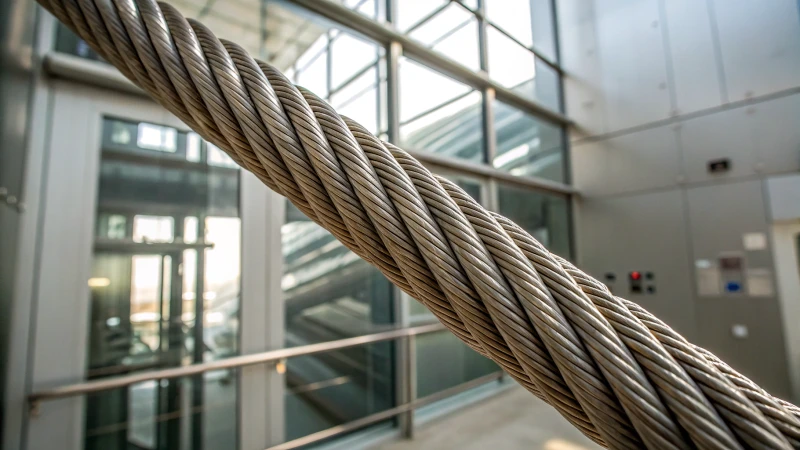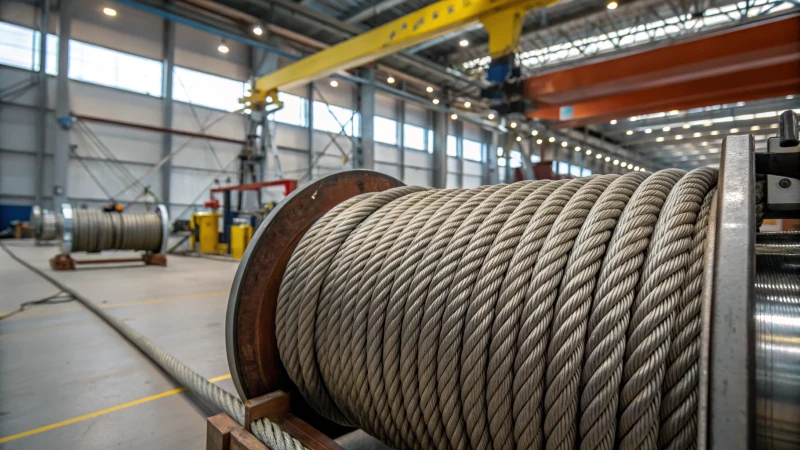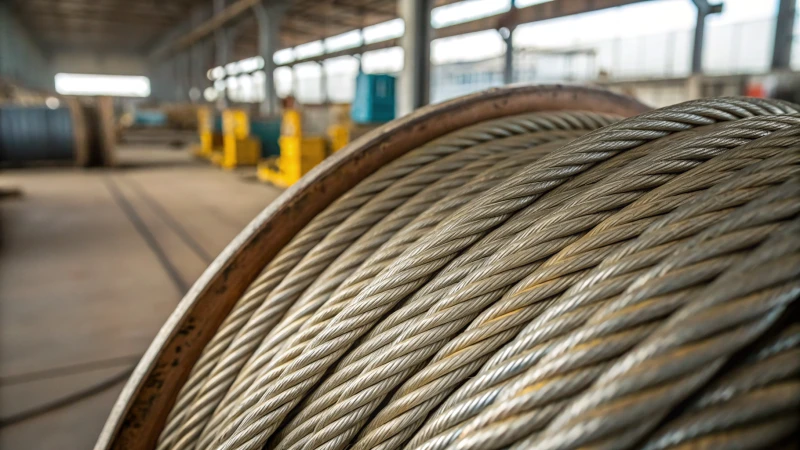
Imagine stepping into an elevator that’s not only smooth and fast but also designed to withstand earthquakes.
Steel wire ropes make seismic-proof elevators safe because their high tensile strength and flexibility help absorb seismic shocks. They maintain integrity under intense forces, ensuring elevator safety during earthquakes.
Thinking back to my own experiences with elevators, I've always felt a mix of wonder and slight apprehension. It's fascinating to consider how these everyday machines are engineered to handle the unpredictable forces of nature. Steel wire ropes play a crucial role here, akin to the seatbelts in your car during a bumpy ride—they're there to keep everything secure and intact. By diving into the specifics of their construction, like the robust high-carbon steel and reinforced cores, you get a sense of how these ropes act as unsung heroes, absorbing shock and maintaining performance even under seismic stress. It’s truly remarkable how they ensure elevators remain operational and safe in earthquake-prone areas.
Steel wire ropes absorb seismic shocks effectively.True
Their high tensile strength and flexibility allow them to withstand seismic forces.
Steel wire ropes lose integrity under lateral forces.False
They maintain integrity even under intense lateral and vertical forces.
How Do Steel Wire Ropes Absorb Seismic Shocks?
Imagine a world where steel wire ropes silently bear the burden of seismic tremors, keeping structures safe and sound.
Steel wire ropes absorb seismic shocks thanks to their impressive tensile strength and flexibility, which allow them to manage and dissipate energy from vibrations. Their effectiveness is enhanced through specific designs like reinforced cores that mitigate seismic forces.

The Role of Material Composition
I remember the first time I learned about the power of steel wire ropes in earthquake-prone areas. It was during a visit to a construction site, where an engineer explained how high-carbon steel, with its robust tensile strength up to 2500 MPa, acts as a guardian against seismic forces. This material is the backbone of these ropes, enabling them to withstand the intense pressures during an earthquake.
But it’s not just about strength. Flexibility plays a crucial role, too. Reinforced cores1 within these ropes serve as energy absorbers, reducing the transfer of seismic energy—an ingenious design that brings peace of mind when the ground beneath us becomes unstable.
Structural Design and Configuration
The design of steel wire ropes is like a symphony, balancing strength and flexibility. I once compared different rope configurations while sourcing for a project and was fascinated by how a 6×19 construction excelled in shock absorption. This particular design maintains an ideal balance, reducing lateral forces during tremors effectively.
| Construction Type | Shock Absorption | Flexibility |
|---|---|---|
| 6×19 | High | Moderate |
| 7×19 | Moderate | High |
| 8×19 | Low | High |
Testing and Standards
Rigorous testing is a non-negotiable step in ensuring safety. I’ve often relied on ISO 7531 testing reports to validate the ropes I procure. These tests confirm that ropes with reinforced cores can cut down force transfer by up to 40%, a statistic that reassures me every time I sign off on an order.
Such stringent testing protocols ensure that these ropes can perform reliably under extreme conditions, proving indispensable in construction projects situated in seismic zones.
Practical Applications in Seismic Zones
Steel wire ropes are vital in various applications, from elevators to cranes. On a project in an earthquake-prone region, I saw firsthand how elevator systems2 fitted with these ropes continued operating smoothly even during minor tremors. Their flexibility allows them to bend and twist without breaking—a true safety net for both machinery and human life.
Future Innovations
The world of steel wire ropes is ever-evolving. During a recent industry conference, I learned about exciting advancements like carbon fiber reinforcements and advanced coating techniques. These innovations promise even greater resilience, paving the way for safer constructions in earthquake-prone areas.
Understanding these mechanisms3 empowers industries to harness these technologies, enhancing safety and efficiency where it matters most.
High-carbon steel is used in wire ropes for seismic absorption.True
High-carbon steel provides excellent tensile strength, crucial for seismic shock absorption.
Ropes with a 6×19 construction offer low shock absorption.False
6×19 construction provides high shock absorption by balancing flexibility and strength.
What Material Properties Enhance Steel Wire Rope Performance?
Ever wondered what makes steel wire ropes so indispensable across various industries? The secret lies in the material properties that enhance their performance, ensuring they withstand the toughest conditions while maintaining reliability and efficiency.
Steel wire ropes excel in performance thanks to properties like high tensile strength, flexibility, corrosion resistance, and fatigue resistance. These attributes are significantly boosted by using high-carbon steel and specialized coatings.

High Tensile Strength and Flexibility
High tensile strength is like the superhero cape of steel wire ropes, allowing them to support massive weights without snapping. I saw this firsthand in a construction project where elevator ropes4 were under constant pressure. The peace of mind knowing these ropes wouldn't give way was invaluable.
Flexibility is equally crucial, enabling the ropes to endure bending without breaking. This was a lifesaver when working in areas prone to seismic activity. A colleague once mentioned how the 6×19 construction ropes we used absorbed shocks effectively, providing an extra layer of safety.
| Property | Importance |
|---|---|
| High Tensile Strength | Supports massive weights |
| Flexibility | Endures bending |
Corrosion Resistance
I can't emphasize enough how critical corrosion resistance is, especially in marine environments where the air is salty and unforgiving. I remember a project off the coast where galvanized steel ropes5 were our go-to choice for their longevity and reliability.
Fatigue Resistance
Fatigue resistance was a game-changer during a long-term project involving cranes and elevators. Specialized coatings on the ropes reduced wear and tear, ensuring they held up under continuous use. It was reassuring to know that the integrity of the equipment wasn't compromised.
Material Composition and Coatings
Using high-carbon steel ropes was like unlocking a new level of durability and strength. The additional PVC or nylon coatings provided protection against external elements, which was crucial in outdoor projects where every little detail mattered.
| Material Type | Benefits |
|---|---|
| High-Carbon Steel | Durability and strength |
| Galvanized Steel | Longevity and reliability |
| Coated Steel | Protection from external elements |
These combined properties make steel wire ropes not just tools but partners in numerous demanding applications across industries. It's a relief knowing that with the right materials, we can always trust these ropes to perform reliably.
High tensile strength allows ropes to handle heavy loads.True
High tensile strength enables steel wire ropes to manage significant weight without breaking.
Corrosion resistance is not important in marine environments.False
Corrosion resistance is crucial in marine settings to prevent degradation.
Why Is the Construction of Steel Wire Ropes Critical in Seismic Zones?
Imagine standing on shaky ground, knowing that something as simple as a steel wire rope is keeping skyscrapers and machinery safe during an earthquake. It's more than just metal; it's a lifeline.
In seismic zones, steel wire ropes are indispensable because they absorb and dissipate seismic energy. Their remarkable tensile strength and flexibility are crucial in preventing structural failures during earthquakes.

Understanding Steel Wire Ropes' Role in Seismic Zones
I remember walking through the bustling streets of San Francisco, where buildings tower over like giants. It was then I realized the silent guardians protecting these structures are steel wire ropes. In seismic zones, the ground can shift violently without warning, posing unique challenges that demand specialized construction materials. Steel wire ropes, with their high tensile strength6 and flexibility, stand out as indispensable protectors. These properties allow them to absorb seismic energy efficiently, reducing the risk of structural collapse and keeping both people and machinery safe.
Key Characteristics of Seismic-Resistant Wire Ropes
| Property | Description |
|---|---|
| Tensile Strength | Can withstand up to 2500 MPa, crucial for load-bearing |
| Flexibility | Enables energy absorption without fracturing |
| Core Reinforcement | Provides additional durability and shock resistance |
Types of Constructions in Seismic Zones
One evening, I chatted with a construction manager who explained why the 6×19 configuration is often their go-to choice. This structure involves six strands with nineteen wires each, striking a perfect balance between flexibility and strength, making it highly effective in shock absorption.
According to ISO 7531 testing data, ropes with reinforced cores can maintain their integrity during seismic events by reducing force transfer by up to 40%. This reduction is critical for minimizing damage to infrastructure, ensuring everything from towering skyscrapers to small businesses remains standing strong.
Applications and Benefits in Seismic Zones
Steel wire ropes are not just theoretical heroes; they play vital roles in everyday machinery like elevators, cranes, and construction equipment. Their ability to resist lateral forces ensures these systems remain operational even during earthquake disturbances7.
Moreover, these ropes provide an added layer of safety in tall buildings where vibration damping is crucial. In places like California and Japan, where the earth's tremors are a regular part of life, using these ropes can significantly enhance building resilience.
For folks like John or Emma—procurement managers who need to select the best steel wire ropes for their projects—it's about more than just ticking boxes. They consider suppliers who offer high-quality materials that meet stringent safety standards. Reliable after-sales support is also essential to ensure the ropes perform optimally over time—because when the ground shakes, you want assurance that the tools holding everything together are up to the task.
Steel wire ropes can reduce seismic force transfer by 40%.True
ISO 7531 testing data shows reinforced core ropes reduce force transfer by up to 40%.
6×19 configuration ropes are less effective in seismic zones.False
The 6×19 configuration is preferred for its balance of flexibility and strength in absorbing shocks.
What Are the Testing Standards for Seismic-Proof Elevator Ropes?
When I first learned about seismic-proof elevator ropes, I was amazed at the level of testing involved to ensure safety during earthquakes. Dive in with me to explore these fascinating standards!
Seismic-proof elevator ropes must meet ISO 7531 standards, focusing on high tensile strength and flexibility. Testing includes tensile strength checks, shock absorption, and lateral force resistance to ensure performance during seismic events.

Understanding ISO 7531 Standards
When I first delved into the world of seismic-proof elevator ropes, it was like uncovering a hidden layer of engineering marvels. The ISO 7531 standard is the backbone here, outlining how these ropes must endure immense tensile loads without snapping under pressure—a must for any building in a quake-prone area.
Key Tests for Seismic-Proof Ropes
- Tensile Strength Test: Imagine the tension of a rope being pulled to its limits. These tests push ropes up to 2500 MPa, ensuring they don't give up when it counts.
- Shock Absorption Assessment: I was particularly intrigued by how ropes with a 6×19 construction8 can absorb energy, bouncing back from shocks like a pro athlete.
- Lateral Force Resistance: Ropes face off against simulated quake forces, proving their resilience against nature's side swipes.
Material and Construction Considerations
In my journey through the world of elevator ropes, I discovered that high-carbon steel with reinforced cores is the hero of this story. This material not only stands firm but cleverly cuts down force transfer by up to 40%—keeping elevators intact when the ground shakes.
Table: Comparison of Rope Constructions
| Rope Type | Tensile Strength (MPa) | Shock Absorption Efficiency |
|---|---|---|
| 6×19 | Up to 2500 | High |
| 8×19 | Up to 2400 | Moderate |
| 7×19 | Up to 2300 | Low |
Regulatory Compliance and Safety
Complying with international safety regulations9 isn't just a box to tick. It's about safeguarding lives and ensuring that these ropes do their job in any seismic event, keeping elevators running smoothly and safely.
Why Testing Standards Matter
These standards are more than technical jargon; they're a lifeline. They ensure that ropes aren't just strong but smartly flexible—ready to hold their ground during an earthquake. For industry folks like us, staying ahead of these requirements is crucial to keeping buildings safe and compliant in quake zones.
ISO 7531 mandates shock absorption tests for elevator ropes.True
ISO 7531 includes criteria for shock absorption to ensure seismic safety.
High-carbon steel cores increase force transfer by 30-40%.False
High-carbon steel cores reduce force transfer by 30-40% during earthquakes.
Conclusion
Steel wire ropes are essential for seismic-proof elevators, providing high tensile strength and flexibility to absorb shocks, ensuring safety and operational integrity during earthquakes.
-
Reinforced cores enhance durability and energy absorption in steel wire ropes, crucial for seismic resistance. ↩
-
Discover how elevator systems incorporate steel wire ropes for enhanced safety in seismic-prone areas. ↩
-
Explore the scientific principles enabling steel materials to absorb seismic energy effectively. ↩
-
Discover how high tensile strength contributes to the safety and efficiency of elevator ropes, particularly under heavy loads. ↩
-
Learn why corrosion-resistant materials are critical for maintaining the durability of steel wire ropes in marine settings. ↩
-
Discover how high tensile strength enhances the performance and safety of steel wire ropes. ↩
-
Learn about the advantages of using steel wire ropes in earthquake-prone areas. ↩
-
Discover why 6×19 constructions are preferred for shock absorption in seismic-proof applications. ↩
-
Explore global safety standards ensuring elevator rope reliability during seismic events. ↩

